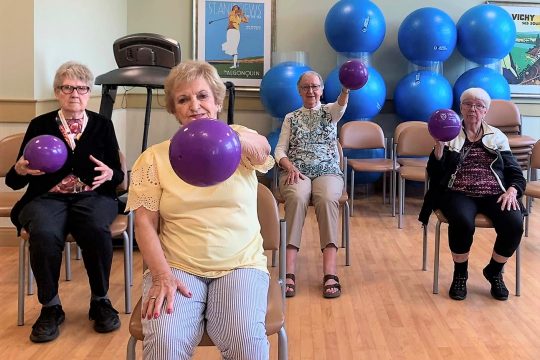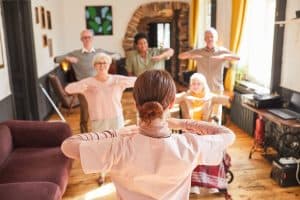
If it’s been a long time since you’ve exercised and you’re feeling less than fit, you might think that it’s too late to make a change. However, the truth is that you can improve your fitness at any age. In fact, deciding to become physically active can be one of the best things you can do for your health.
Exercise is important in all phases of life, but for seniors, it’s critical to maintaining independence, among other benefits. Let’s talk about how to get started.
How Older Adults Can Get Back into Exercise
 Finding the motivation to work out isn’t always easy, and if you find yourself constantly swerving exercise sessions, you’re not alone. To help build motivation, learn to view exercise as some quality “me” time. If that doesn’t work, try the 10-Minute Rule. Here’s how it works: Set aside the next 10 minutes to exercise. You can set a timer if you want. Once the 10 minutes are up, decide whether or not you will continue. Nine times out of ten, people decide to keep going. Here are some other strategies to help you get back into exercise.
Finding the motivation to work out isn’t always easy, and if you find yourself constantly swerving exercise sessions, you’re not alone. To help build motivation, learn to view exercise as some quality “me” time. If that doesn’t work, try the 10-Minute Rule. Here’s how it works: Set aside the next 10 minutes to exercise. You can set a timer if you want. Once the 10 minutes are up, decide whether or not you will continue. Nine times out of ten, people decide to keep going. Here are some other strategies to help you get back into exercise.
1. Understand the Importance of Staying Active:
Exercise is not just about maintaining a slim physique. For seniors, regular physical activity can:
- Boost mood and alleviate symptoms of depression.
- Enhance mobility, balance, and flexibility.
- Improve sleep patterns.
- Reduce the risk of chronic diseases.
- Strengthen bones, which can prevent osteoporosis.
- Increase social interaction if participating in group activities.
- Contribute to longevity, adding extra years to your life—even if you don’t start exercising until your senior years.
2. Seek Medical Clearance:
Always consult with your healthcare provider before starting any exercise routine. They can provide guidelines tailored to your health condition, ensuring you approach fitness safely.
3. Start Slow:
After a long hiatus, or if you’re exercising for the first time, it’s essential to start slowly to avoid injuries. Begin with low-impact exercises, like walking or swimming, before gradually increasing intensity.
4. Choose the Right Activities:
If you use a cane, walker, or are chair-bound, there are plenty of exercise options available to you. You can lift light weights, stretch, and do chair aerobics, chair yoga, and chair tai chi to increase your range of motion, improve muscle tone and flexibility, and promote cardiovascular health. Also, many swimming pools are accessible to wheelchair users and you can also participate in adaptive exercise programs such as basketball or dancing.
5. Incorporate Strength Training:
Just hearing the words weight lifting or weight training can inspire nervousness, especially for older adults who’ve never spent much time in the gym. Yet strength training is an important part of any overall fitness program.
According to the Mayo Clinic, muscle mass tends to decrease with age, leading to frailty and a decline in functional strength. Lifting light weights, using resistance bands, or performing body-weight exercises like squats can be beneficial and help seniors to build muscle mass. Consider hiring a personal trainer to help you get started. If you live in a retirement community, ask the Health & Wellness staff for guidance.
6. Embrace Flexibility and Balance
Incorporate stretches into your routine to improve flexibility and reduce muscle stiffness. Balance exercises, like tai chi or simple heel-to-toe walks, can help reduce the risk of falls.
7. Stay Hydrated
As we age, our sense of thirst diminishes. Remember to drink water before, during, and after exercise to prevent dehydration, cramps, and overheating.
8. Listen to Your Body
Always pay attention to how your body feels during and after workouts. Being active and moving can help you manage pain and improve your strength and self-confidence. However, if something doesn’t feel right or causes pain, take a break or modify the activity.
9. Join a Group or Class
Consider enrolling in senior fitness classes in your retirement community, community centre, or at a gym. Exercising in a group can be motivating and offers a great way to meet new friends with similar goals.
10. Stay Consistent
Consistency is key to reaping the benefits of exercise. Make a schedule, set reminders, and try to stick to your routine. If you miss a day, don’t get discouraged; just pick up where you left off.
11. Set Realistic Goals
Whether it’s walking a certain distance, lifting a specific weight, or simply staying active for 30 minutes daily, set achievable goals. Celebrate each accomplishment, no matter how small.
12. Incorporate Daily Activities
Simple daily tasks, like gardening, walking the dog, or dancing, can also provide substantial health benefits. It’s about staying active and enjoying the process.
Exercising in Senior Communities
 One of the many benefits of living in an active living community is that we have Health and Wellness Directors – friendly staff members who work closely with you to find safe and effective activities to reach your fitness goals and overcome barriers to participation.
One of the many benefits of living in an active living community is that we have Health and Wellness Directors – friendly staff members who work closely with you to find safe and effective activities to reach your fitness goals and overcome barriers to participation.
Beyond their beautifully-appointed surroundings, communities like our retirement homes Hamilton Mountain and senior housing Calgary are havens of active, rejuvenating lifestyles. Every corner is thoughtfully crafted to re-introduce seniors to the joy of physical activity, tailored to their unique needs. With the guidance of trained professionals, residents are eased back into fitness routines, ensuring they experience the myriad benefits of exercise in their golden years. Not to mention facilities such as pools, gyms with strength-oriented equipment, and numerous activities for you to join. At All Seniors Care, it’s more than just retirement living; it’s about celebrating each day with vitality, grace, and a zest for life.
If you’d like to find out more about us and the benefits and attractions of living in an All Seniors Care community, get in touch today or read our blog on the benefits of living in a retirement residence.
Writer – Julianna McLeod
Julianna is a health and wellness expert at All Seniors Care. Her mission is to create content that empowers seniors to form sustainable solutions for lasting health and happiness. She is an experienced writer, editor, and Recreational Therapist living in Toronto.
